An Analysis of Efficient Consumer Response in Fast Food Supply Chains
VerifiedAdded on 2021/11/16
|39
|8361
|103
Report
AI Summary
This report provides a comprehensive analysis of Efficient Consumer Response (ECR) within the fast food supply chain. It delves into the core components of ECR, including continuous replenishment, vendor-managed inventory, and cross-docking, and explores key strategies such as efficient store assortment, efficient replenishment, promotion, and product introduction. The paper examines the working of supply chain management in the fast food industry, highlighting challenges and benefits like cold supply chains and the application of the Internet of Things. Furthermore, it discusses ECR implementation, efficient product replenishment, and information systems, culminating in a case study of McDonald's to illustrate ECR's practical advantages. The report underscores how ECR enhances efficiency, reduces costs, and improves customer satisfaction in the fast food sector.
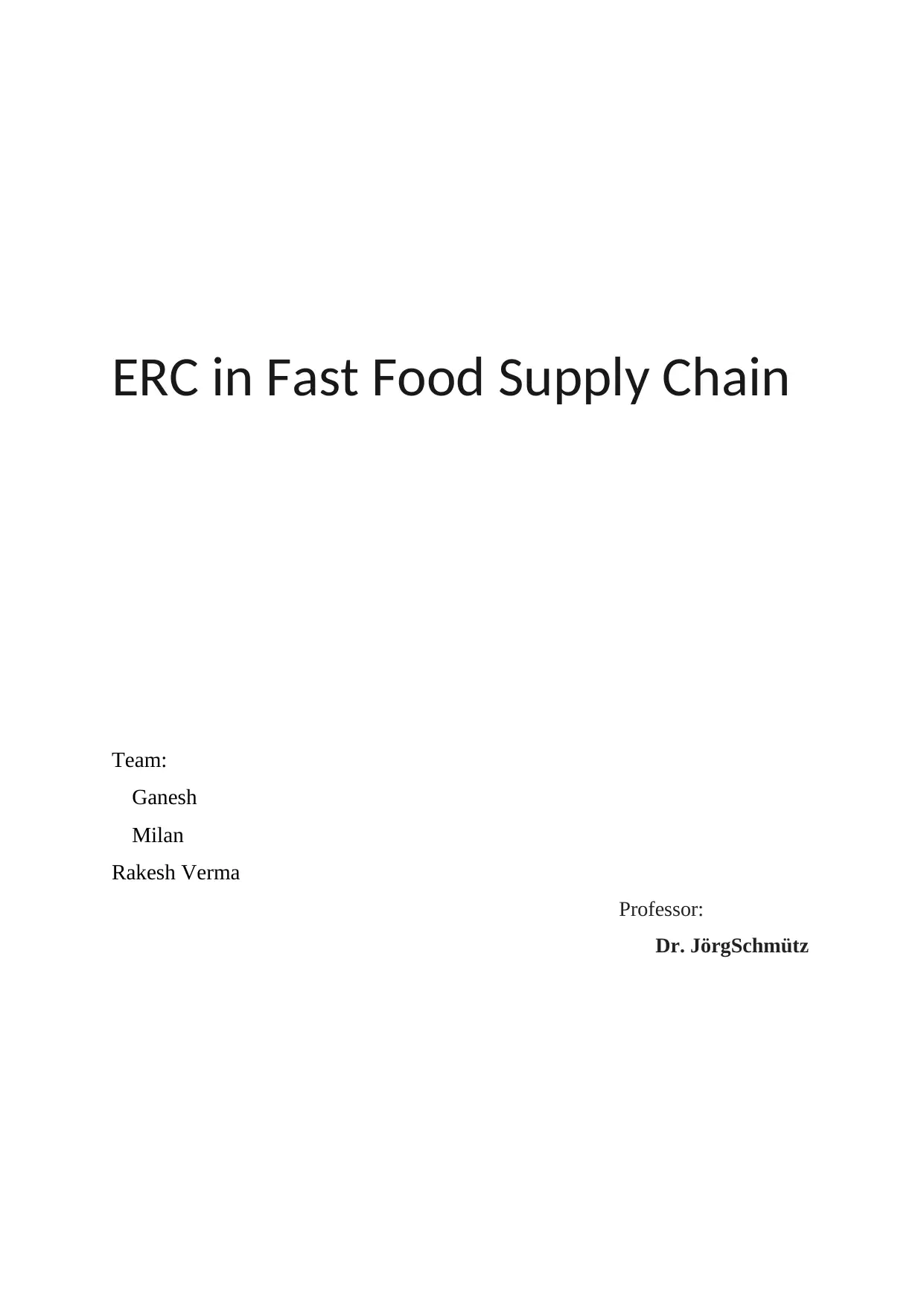
ERC in Fast Food Supply Chain
Team:
Ganesh
Milan
Rakesh Verma
Professor:
Dr. JörgSchmütz
Team:
Ganesh
Milan
Rakesh Verma
Professor:
Dr. JörgSchmütz
Paraphrase This Document
Need a fresh take? Get an instant paraphrase of this document with our AI Paraphraser
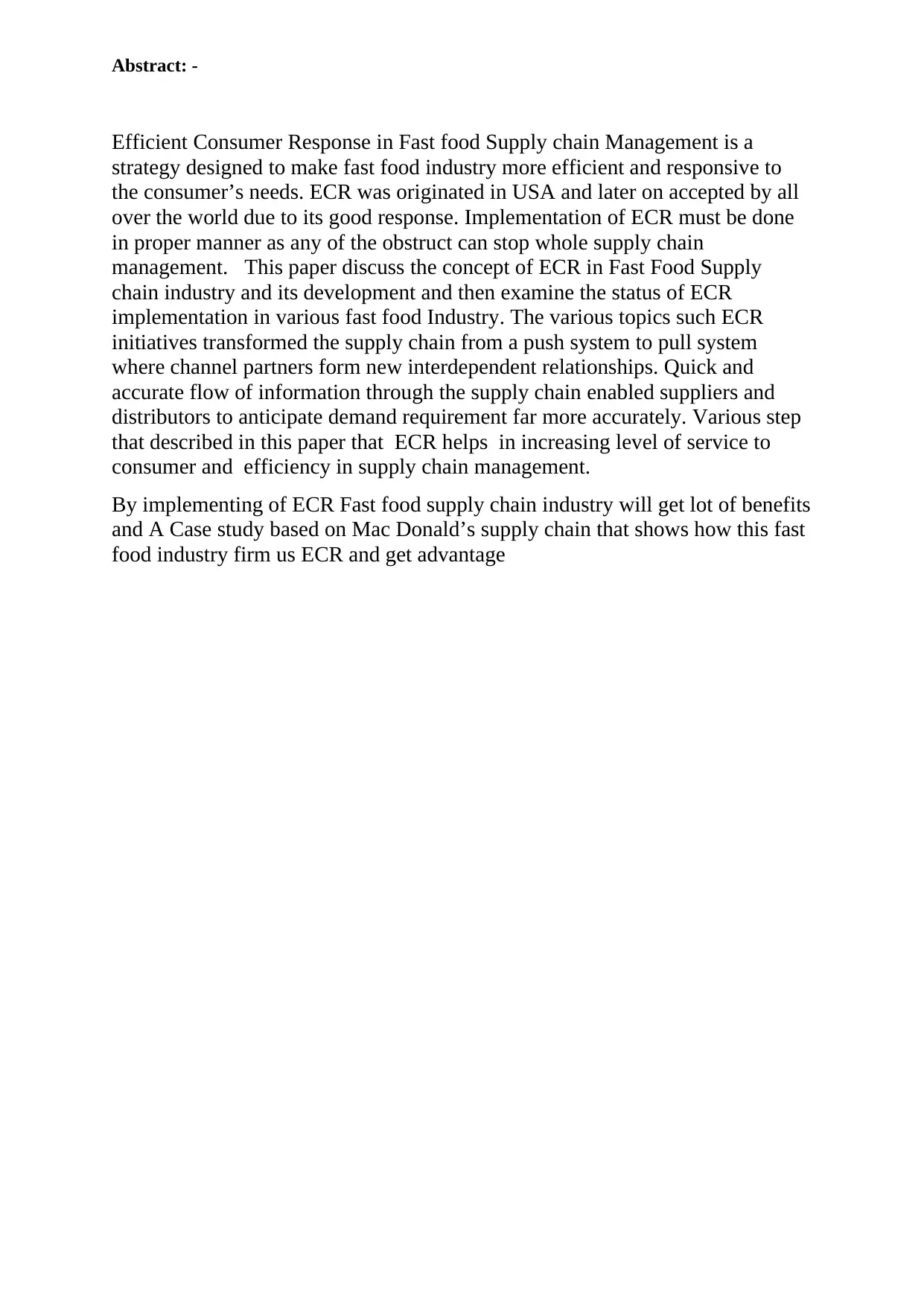
Abstract: -
Efficient Consumer Response in Fast food Supply chain Management is a
strategy designed to make fast food industry more efficient and responsive to
the consumer’s needs. ECR was originated in USA and later on accepted by all
over the world due to its good response. Implementation of ECR must be done
in proper manner as any of the obstruct can stop whole supply chain
management. This paper discuss the concept of ECR in Fast Food Supply
chain industry and its development and then examine the status of ECR
implementation in various fast food Industry. The various topics such ECR
initiatives transformed the supply chain from a push system to pull system
where channel partners form new interdependent relationships. Quick and
accurate flow of information through the supply chain enabled suppliers and
distributors to anticipate demand requirement far more accurately. Various step
that described in this paper that ECR helps in increasing level of service to
consumer and efficiency in supply chain management.
By implementing of ECR Fast food supply chain industry will get lot of benefits
and A Case study based on Mac Donald’s supply chain that shows how this fast
food industry firm us ECR and get advantage
Efficient Consumer Response in Fast food Supply chain Management is a
strategy designed to make fast food industry more efficient and responsive to
the consumer’s needs. ECR was originated in USA and later on accepted by all
over the world due to its good response. Implementation of ECR must be done
in proper manner as any of the obstruct can stop whole supply chain
management. This paper discuss the concept of ECR in Fast Food Supply
chain industry and its development and then examine the status of ECR
implementation in various fast food Industry. The various topics such ECR
initiatives transformed the supply chain from a push system to pull system
where channel partners form new interdependent relationships. Quick and
accurate flow of information through the supply chain enabled suppliers and
distributors to anticipate demand requirement far more accurately. Various step
that described in this paper that ECR helps in increasing level of service to
consumer and efficiency in supply chain management.
By implementing of ECR Fast food supply chain industry will get lot of benefits
and A Case study based on Mac Donald’s supply chain that shows how this fast
food industry firm us ECR and get advantage
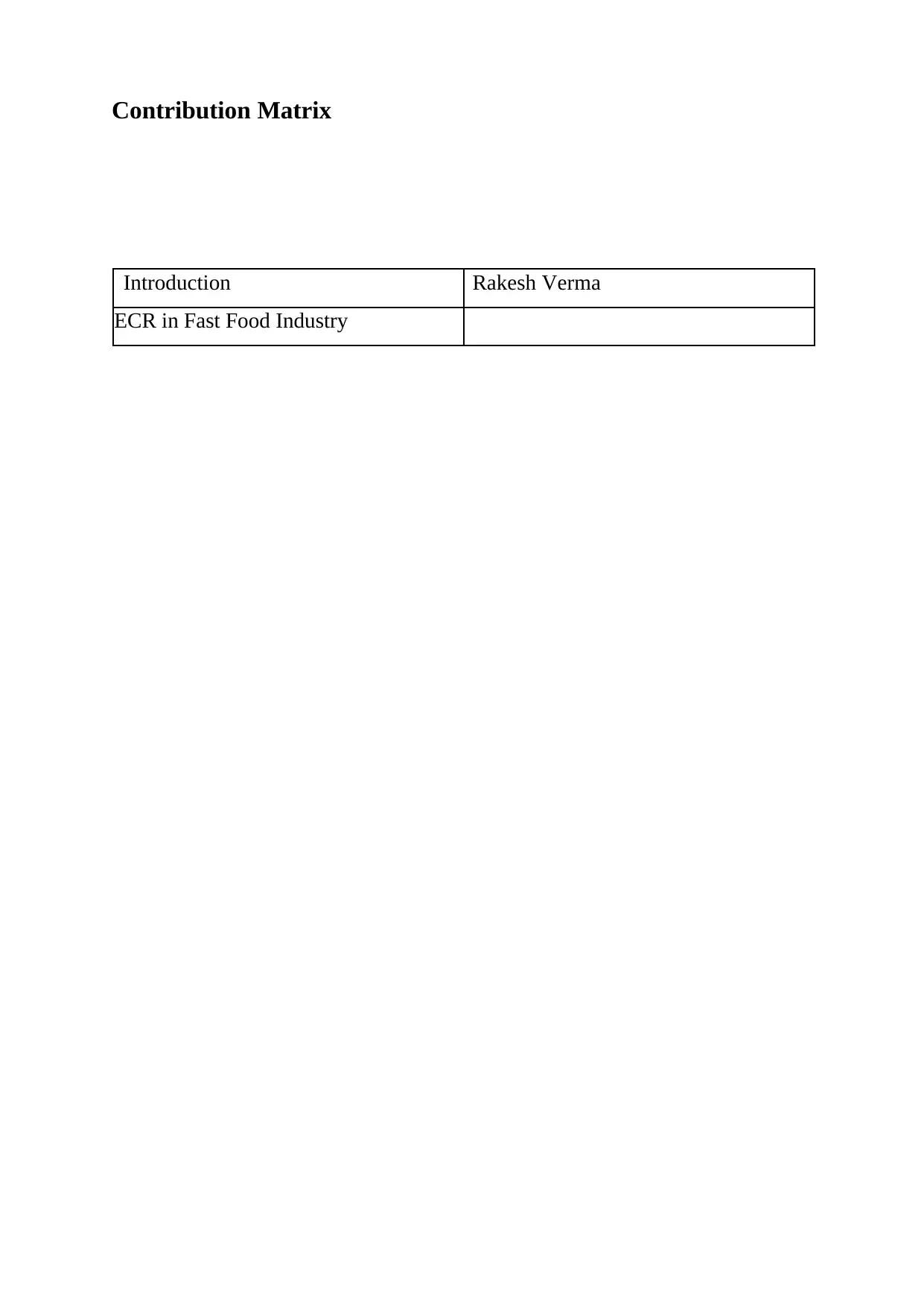
Contribution Matrix
Introduction Rakesh Verma
ECR in Fast Food Industry
Introduction Rakesh Verma
ECR in Fast Food Industry
⊘ This is a preview!⊘
Do you want full access?
Subscribe today to unlock all pages.

Trusted by 1+ million students worldwide

Paraphrase This Document
Need a fresh take? Get an instant paraphrase of this document with our AI Paraphraser
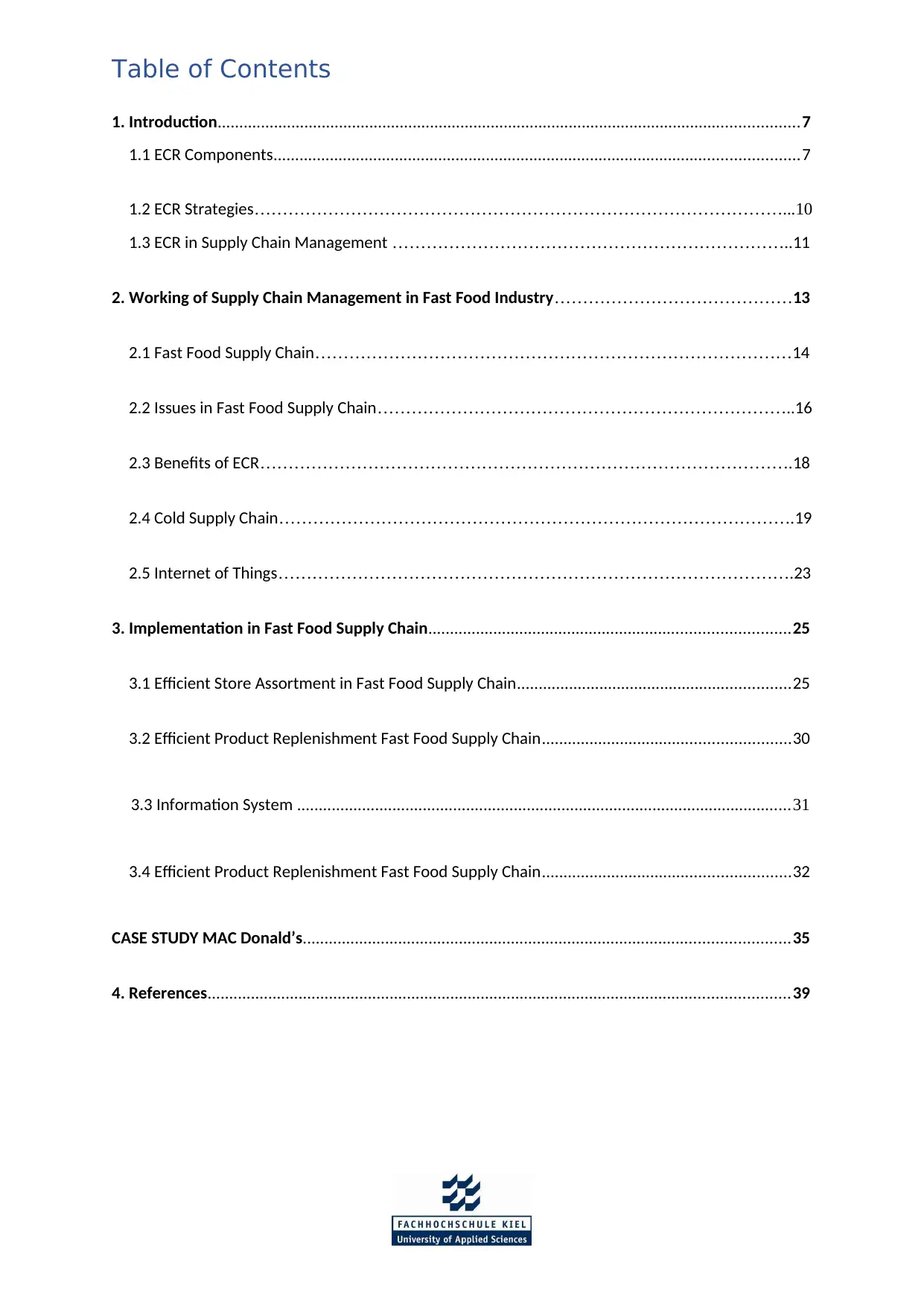
Table of Contents
1. Introduction......................................................................................................................................7
1.1 ECR Components.........................................................................................................................7
1.2 ECR Strategies…………………………………………………………………………………...10
1.3 ECR in Supply Chain Management ……………………………………………………………..11
2. Working of Supply Chain Management in Fast Food Industry……………………………………13
2.1 Fast Food Supply Chain…………………………………………………………………………14
2.2 Issues in Fast Food Supply Chain………………………………………………………………..16
2.3 Benefits of ECR………………………………………………………………………………….18
2.4 Cold Supply Chain……………………………………………………………………………….19
2.5 Internet of Things……………………………………………………………………………….23
3. Implementation in Fast Food Supply Chain...................................................................................25
3.1 Efficient Store Assortment in Fast Food Supply Chain...............................................................25
3.2 Efficient Product Replenishment Fast Food Supply Chain.........................................................30
3.3 Information System ..................................................................................................................31
3.4 Efficient Product Replenishment Fast Food Supply Chain.........................................................32
CASE STUDY MAC Donald’s................................................................................................................35
4. References......................................................................................................................................39
1. Introduction......................................................................................................................................7
1.1 ECR Components.........................................................................................................................7
1.2 ECR Strategies…………………………………………………………………………………...10
1.3 ECR in Supply Chain Management ……………………………………………………………..11
2. Working of Supply Chain Management in Fast Food Industry……………………………………13
2.1 Fast Food Supply Chain…………………………………………………………………………14
2.2 Issues in Fast Food Supply Chain………………………………………………………………..16
2.3 Benefits of ECR………………………………………………………………………………….18
2.4 Cold Supply Chain……………………………………………………………………………….19
2.5 Internet of Things……………………………………………………………………………….23
3. Implementation in Fast Food Supply Chain...................................................................................25
3.1 Efficient Store Assortment in Fast Food Supply Chain...............................................................25
3.2 Efficient Product Replenishment Fast Food Supply Chain.........................................................30
3.3 Information System ..................................................................................................................31
3.4 Efficient Product Replenishment Fast Food Supply Chain.........................................................32
CASE STUDY MAC Donald’s................................................................................................................35
4. References......................................................................................................................................39

⊘ This is a preview!⊘
Do you want full access?
Subscribe today to unlock all pages.

Trusted by 1+ million students worldwide
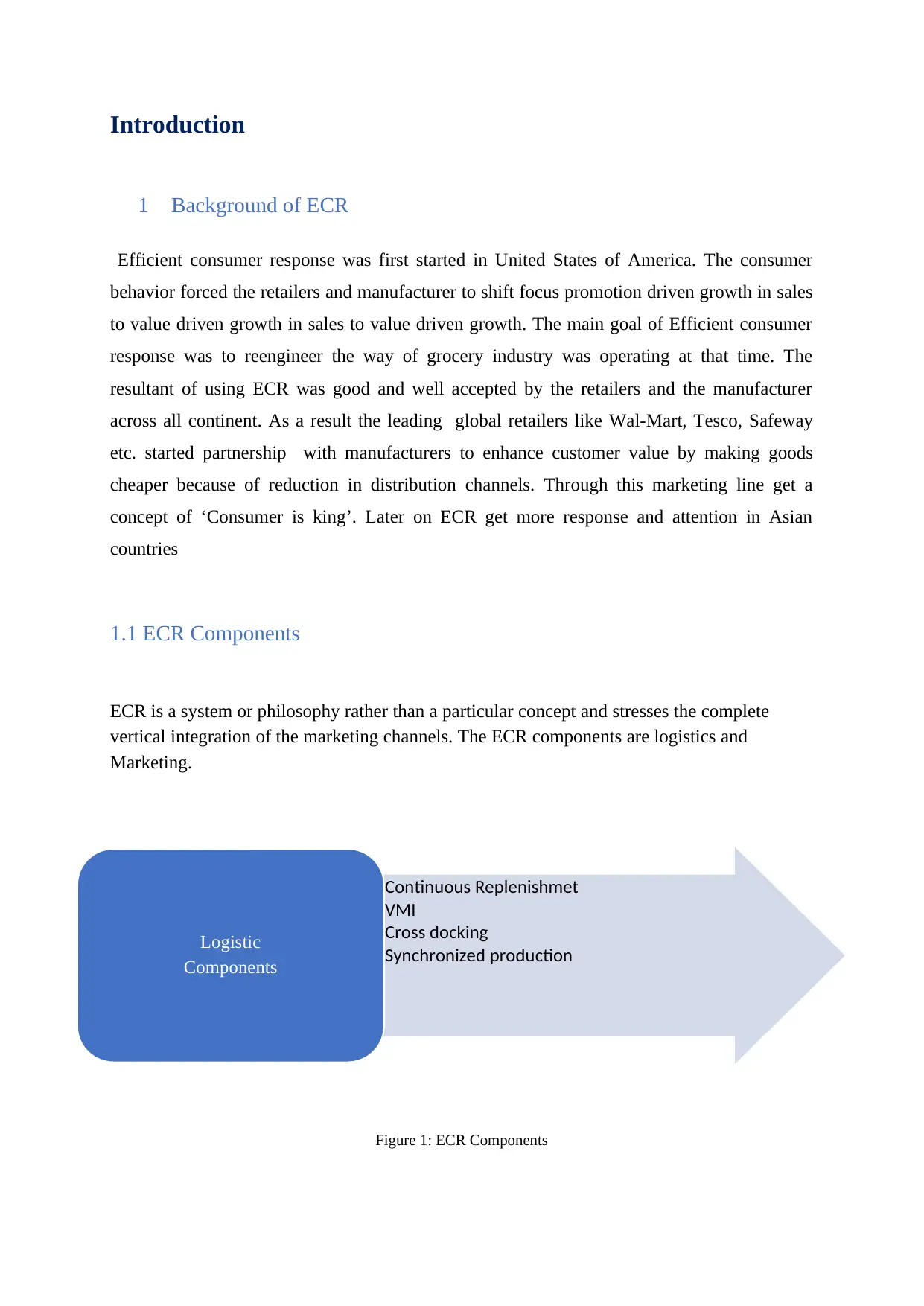
Introduction
1 Background of ECR
Efficient consumer response was first started in United States of America. The consumer
behavior forced the retailers and manufacturer to shift focus promotion driven growth in sales
to value driven growth in sales to value driven growth. The main goal of Efficient consumer
response was to reengineer the way of grocery industry was operating at that time. The
resultant of using ECR was good and well accepted by the retailers and the manufacturer
across all continent. As a result the leading global retailers like Wal-Mart, Tesco, Safeway
etc. started partnership with manufacturers to enhance customer value by making goods
cheaper because of reduction in distribution channels. Through this marketing line get a
concept of ‘Consumer is king’. Later on ECR get more response and attention in Asian
countries
1.1 ECR Components
ECR is a system or philosophy rather than a particular concept and stresses the complete
vertical integration of the marketing channels. The ECR components are logistics and
Marketing.
Figure 1: ECR Components
Continuous Replenishmet
VMI
Cross docking
Synchronized production
Logistic
Components
1 Background of ECR
Efficient consumer response was first started in United States of America. The consumer
behavior forced the retailers and manufacturer to shift focus promotion driven growth in sales
to value driven growth in sales to value driven growth. The main goal of Efficient consumer
response was to reengineer the way of grocery industry was operating at that time. The
resultant of using ECR was good and well accepted by the retailers and the manufacturer
across all continent. As a result the leading global retailers like Wal-Mart, Tesco, Safeway
etc. started partnership with manufacturers to enhance customer value by making goods
cheaper because of reduction in distribution channels. Through this marketing line get a
concept of ‘Consumer is king’. Later on ECR get more response and attention in Asian
countries
1.1 ECR Components
ECR is a system or philosophy rather than a particular concept and stresses the complete
vertical integration of the marketing channels. The ECR components are logistics and
Marketing.
Figure 1: ECR Components
Continuous Replenishmet
VMI
Cross docking
Synchronized production
Logistic
Components
Paraphrase This Document
Need a fresh take? Get an instant paraphrase of this document with our AI Paraphraser
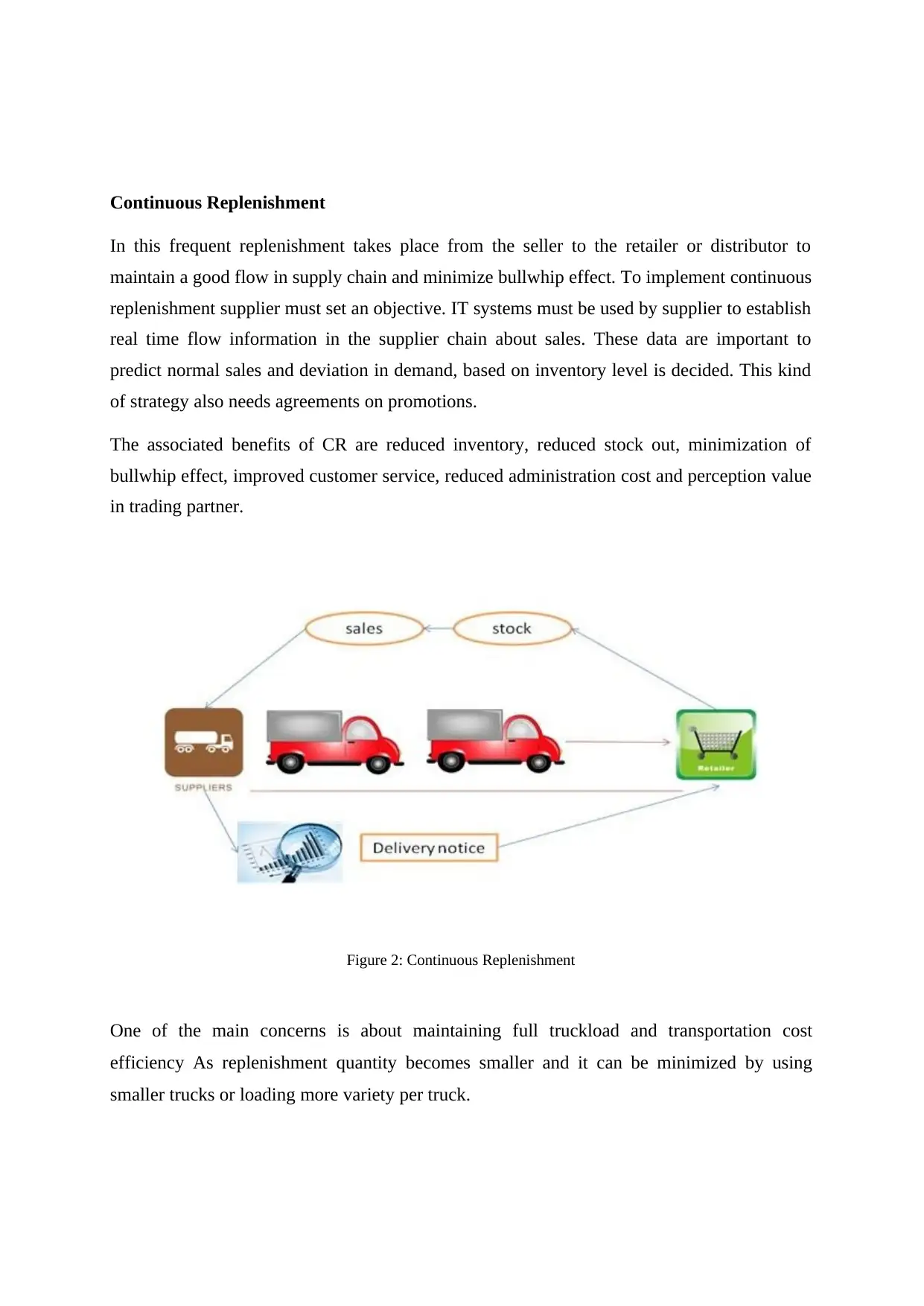
Continuous Replenishment
In this frequent replenishment takes place from the seller to the retailer or distributor to
maintain a good flow in supply chain and minimize bullwhip effect. To implement continuous
replenishment supplier must set an objective. IT systems must be used by supplier to establish
real time flow information in the supplier chain about sales. These data are important to
predict normal sales and deviation in demand, based on inventory level is decided. This kind
of strategy also needs agreements on promotions.
The associated benefits of CR are reduced inventory, reduced stock out, minimization of
bullwhip effect, improved customer service, reduced administration cost and perception value
in trading partner.
Figure 2: Continuous Replenishment
One of the main concerns is about maintaining full truckload and transportation cost
efficiency As replenishment quantity becomes smaller and it can be minimized by using
smaller trucks or loading more variety per truck.
In this frequent replenishment takes place from the seller to the retailer or distributor to
maintain a good flow in supply chain and minimize bullwhip effect. To implement continuous
replenishment supplier must set an objective. IT systems must be used by supplier to establish
real time flow information in the supplier chain about sales. These data are important to
predict normal sales and deviation in demand, based on inventory level is decided. This kind
of strategy also needs agreements on promotions.
The associated benefits of CR are reduced inventory, reduced stock out, minimization of
bullwhip effect, improved customer service, reduced administration cost and perception value
in trading partner.
Figure 2: Continuous Replenishment
One of the main concerns is about maintaining full truckload and transportation cost
efficiency As replenishment quantity becomes smaller and it can be minimized by using
smaller trucks or loading more variety per truck.
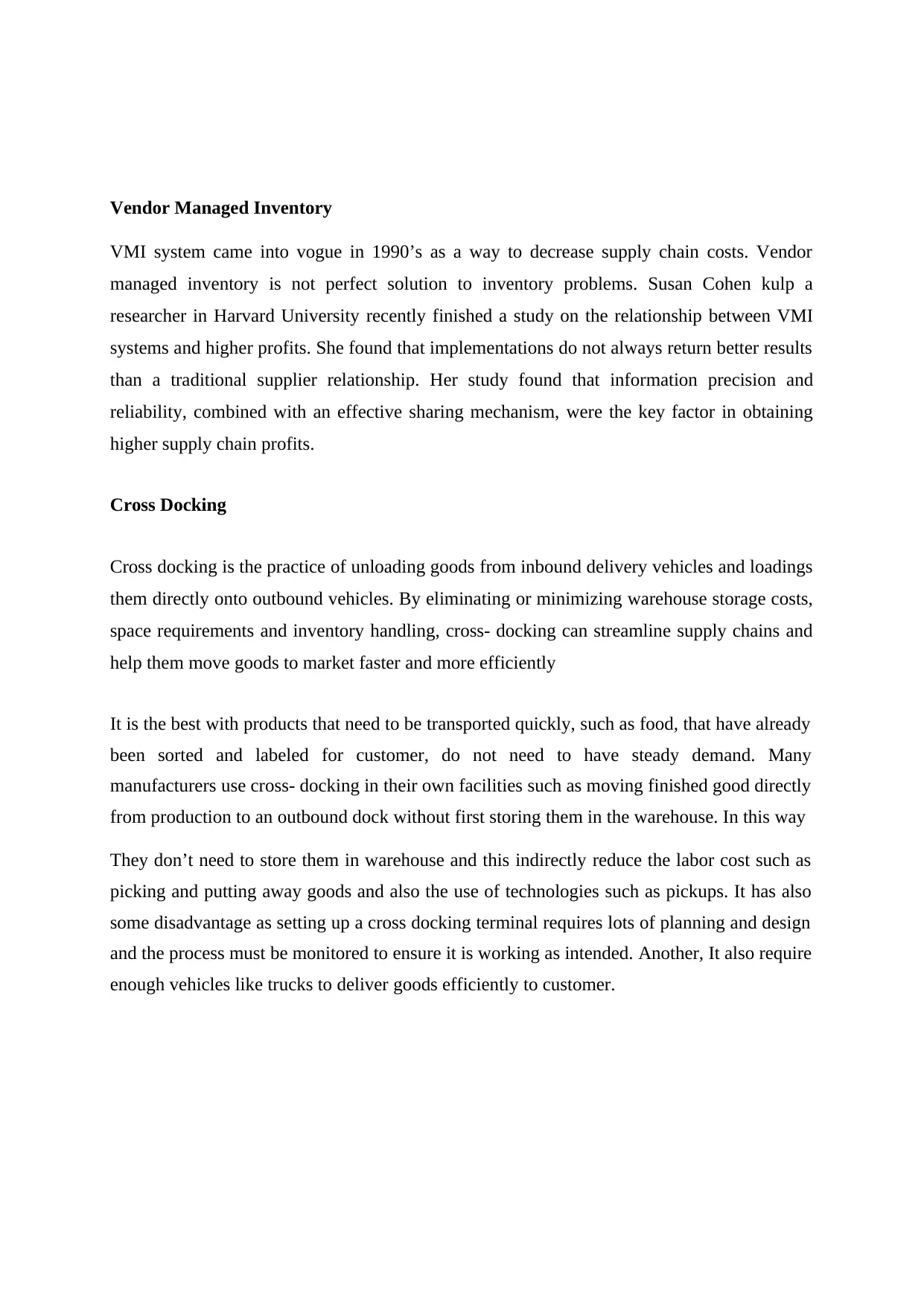
Vendor Managed Inventory
VMI system came into vogue in 1990’s as a way to decrease supply chain costs. Vendor
managed inventory is not perfect solution to inventory problems. Susan Cohen kulp a
researcher in Harvard University recently finished a study on the relationship between VMI
systems and higher profits. She found that implementations do not always return better results
than a traditional supplier relationship. Her study found that information precision and
reliability, combined with an effective sharing mechanism, were the key factor in obtaining
higher supply chain profits.
Cross Docking
Cross docking is the practice of unloading goods from inbound delivery vehicles and loadings
them directly onto outbound vehicles. By eliminating or minimizing warehouse storage costs,
space requirements and inventory handling, cross- docking can streamline supply chains and
help them move goods to market faster and more efficiently
It is the best with products that need to be transported quickly, such as food, that have already
been sorted and labeled for customer, do not need to have steady demand. Many
manufacturers use cross- docking in their own facilities such as moving finished good directly
from production to an outbound dock without first storing them in the warehouse. In this way
They don’t need to store them in warehouse and this indirectly reduce the labor cost such as
picking and putting away goods and also the use of technologies such as pickups. It has also
some disadvantage as setting up a cross docking terminal requires lots of planning and design
and the process must be monitored to ensure it is working as intended. Another, It also require
enough vehicles like trucks to deliver goods efficiently to customer.
VMI system came into vogue in 1990’s as a way to decrease supply chain costs. Vendor
managed inventory is not perfect solution to inventory problems. Susan Cohen kulp a
researcher in Harvard University recently finished a study on the relationship between VMI
systems and higher profits. She found that implementations do not always return better results
than a traditional supplier relationship. Her study found that information precision and
reliability, combined with an effective sharing mechanism, were the key factor in obtaining
higher supply chain profits.
Cross Docking
Cross docking is the practice of unloading goods from inbound delivery vehicles and loadings
them directly onto outbound vehicles. By eliminating or minimizing warehouse storage costs,
space requirements and inventory handling, cross- docking can streamline supply chains and
help them move goods to market faster and more efficiently
It is the best with products that need to be transported quickly, such as food, that have already
been sorted and labeled for customer, do not need to have steady demand. Many
manufacturers use cross- docking in their own facilities such as moving finished good directly
from production to an outbound dock without first storing them in the warehouse. In this way
They don’t need to store them in warehouse and this indirectly reduce the labor cost such as
picking and putting away goods and also the use of technologies such as pickups. It has also
some disadvantage as setting up a cross docking terminal requires lots of planning and design
and the process must be monitored to ensure it is working as intended. Another, It also require
enough vehicles like trucks to deliver goods efficiently to customer.
⊘ This is a preview!⊘
Do you want full access?
Subscribe today to unlock all pages.

Trusted by 1+ million students worldwide
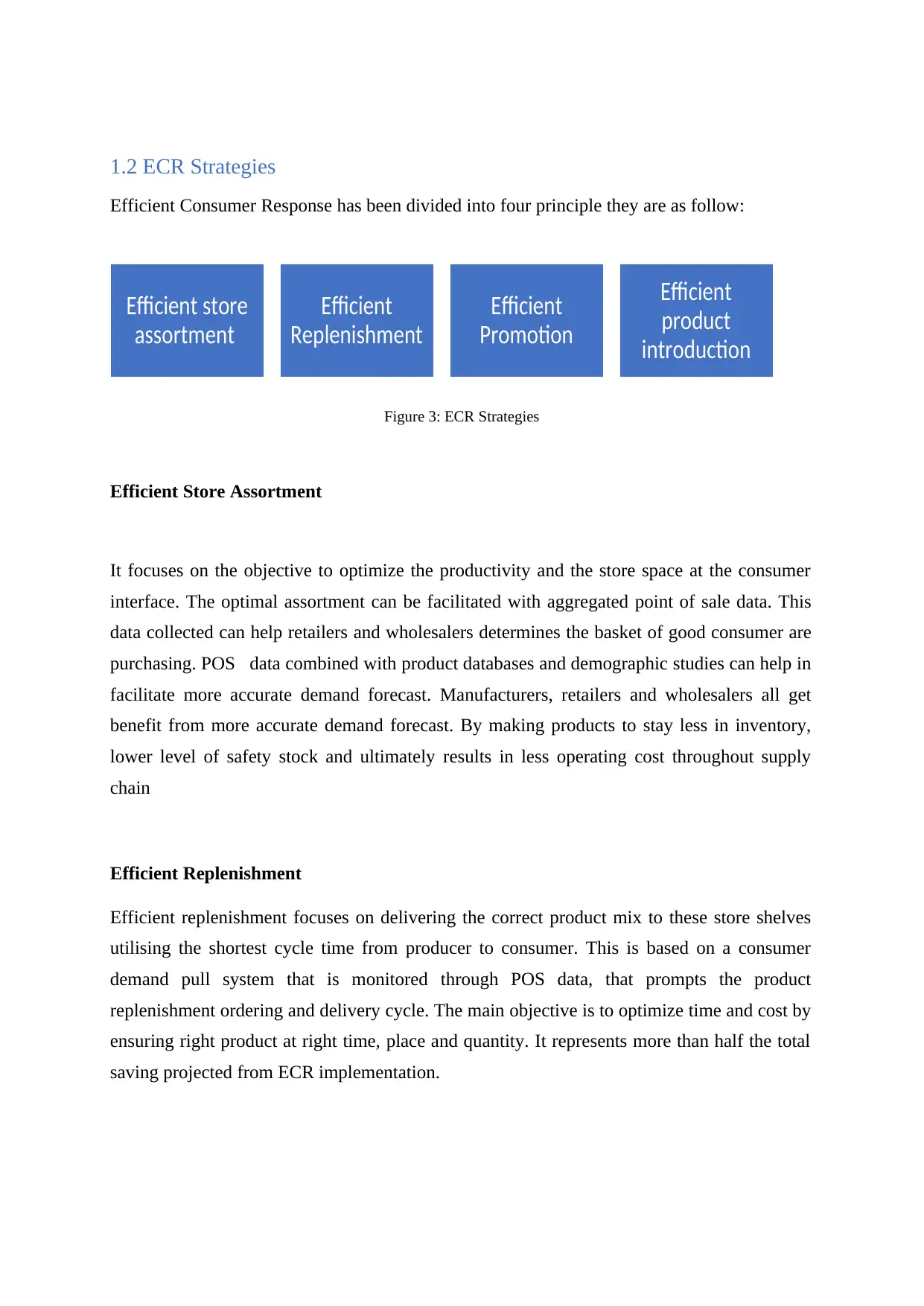
1.2 ECR Strategies
Efficient Consumer Response has been divided into four principle they are as follow:
Figure 3: ECR Strategies
Efficient Store Assortment
It focuses on the objective to optimize the productivity and the store space at the consumer
interface. The optimal assortment can be facilitated with aggregated point of sale data. This
data collected can help retailers and wholesalers determines the basket of good consumer are
purchasing. POS data combined with product databases and demographic studies can help in
facilitate more accurate demand forecast. Manufacturers, retailers and wholesalers all get
benefit from more accurate demand forecast. By making products to stay less in inventory,
lower level of safety stock and ultimately results in less operating cost throughout supply
chain
Efficient Replenishment
Efficient replenishment focuses on delivering the correct product mix to these store shelves
utilising the shortest cycle time from producer to consumer. This is based on a consumer
demand pull system that is monitored through POS data, that prompts the product
replenishment ordering and delivery cycle. The main objective is to optimize time and cost by
ensuring right product at right time, place and quantity. It represents more than half the total
saving projected from ECR implementation.
Efficient store
assortment
Efficient
Replenishment
Efficient
Promotion
Efficient
product
introduction
Efficient Consumer Response has been divided into four principle they are as follow:
Figure 3: ECR Strategies
Efficient Store Assortment
It focuses on the objective to optimize the productivity and the store space at the consumer
interface. The optimal assortment can be facilitated with aggregated point of sale data. This
data collected can help retailers and wholesalers determines the basket of good consumer are
purchasing. POS data combined with product databases and demographic studies can help in
facilitate more accurate demand forecast. Manufacturers, retailers and wholesalers all get
benefit from more accurate demand forecast. By making products to stay less in inventory,
lower level of safety stock and ultimately results in less operating cost throughout supply
chain
Efficient Replenishment
Efficient replenishment focuses on delivering the correct product mix to these store shelves
utilising the shortest cycle time from producer to consumer. This is based on a consumer
demand pull system that is monitored through POS data, that prompts the product
replenishment ordering and delivery cycle. The main objective is to optimize time and cost by
ensuring right product at right time, place and quantity. It represents more than half the total
saving projected from ECR implementation.
Efficient store
assortment
Efficient
Replenishment
Efficient
Promotion
Efficient
product
introduction
Paraphrase This Document
Need a fresh take? Get an instant paraphrase of this document with our AI Paraphraser
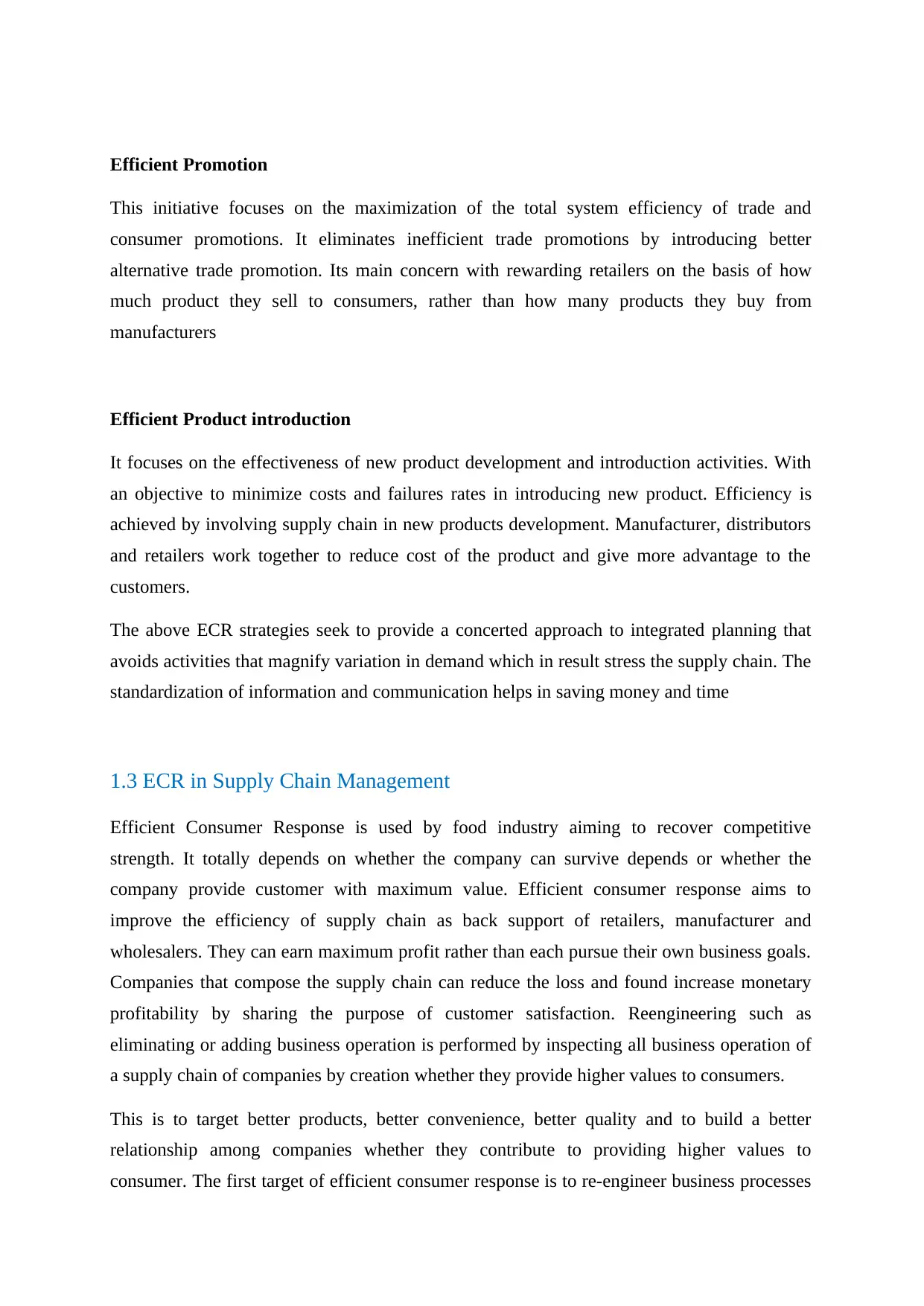
Efficient Promotion
This initiative focuses on the maximization of the total system efficiency of trade and
consumer promotions. It eliminates inefficient trade promotions by introducing better
alternative trade promotion. Its main concern with rewarding retailers on the basis of how
much product they sell to consumers, rather than how many products they buy from
manufacturers
Efficient Product introduction
It focuses on the effectiveness of new product development and introduction activities. With
an objective to minimize costs and failures rates in introducing new product. Efficiency is
achieved by involving supply chain in new products development. Manufacturer, distributors
and retailers work together to reduce cost of the product and give more advantage to the
customers.
The above ECR strategies seek to provide a concerted approach to integrated planning that
avoids activities that magnify variation in demand which in result stress the supply chain. The
standardization of information and communication helps in saving money and time
1.3 ECR in Supply Chain Management
Efficient Consumer Response is used by food industry aiming to recover competitive
strength. It totally depends on whether the company can survive depends or whether the
company provide customer with maximum value. Efficient consumer response aims to
improve the efficiency of supply chain as back support of retailers, manufacturer and
wholesalers. They can earn maximum profit rather than each pursue their own business goals.
Companies that compose the supply chain can reduce the loss and found increase monetary
profitability by sharing the purpose of customer satisfaction. Reengineering such as
eliminating or adding business operation is performed by inspecting all business operation of
a supply chain of companies by creation whether they provide higher values to consumers.
This is to target better products, better convenience, better quality and to build a better
relationship among companies whether they contribute to providing higher values to
consumer. The first target of efficient consumer response is to re-engineer business processes
This initiative focuses on the maximization of the total system efficiency of trade and
consumer promotions. It eliminates inefficient trade promotions by introducing better
alternative trade promotion. Its main concern with rewarding retailers on the basis of how
much product they sell to consumers, rather than how many products they buy from
manufacturers
Efficient Product introduction
It focuses on the effectiveness of new product development and introduction activities. With
an objective to minimize costs and failures rates in introducing new product. Efficiency is
achieved by involving supply chain in new products development. Manufacturer, distributors
and retailers work together to reduce cost of the product and give more advantage to the
customers.
The above ECR strategies seek to provide a concerted approach to integrated planning that
avoids activities that magnify variation in demand which in result stress the supply chain. The
standardization of information and communication helps in saving money and time
1.3 ECR in Supply Chain Management
Efficient Consumer Response is used by food industry aiming to recover competitive
strength. It totally depends on whether the company can survive depends or whether the
company provide customer with maximum value. Efficient consumer response aims to
improve the efficiency of supply chain as back support of retailers, manufacturer and
wholesalers. They can earn maximum profit rather than each pursue their own business goals.
Companies that compose the supply chain can reduce the loss and found increase monetary
profitability by sharing the purpose of customer satisfaction. Reengineering such as
eliminating or adding business operation is performed by inspecting all business operation of
a supply chain of companies by creation whether they provide higher values to consumers.
This is to target better products, better convenience, better quality and to build a better
relationship among companies whether they contribute to providing higher values to
consumer. The first target of efficient consumer response is to re-engineer business processes
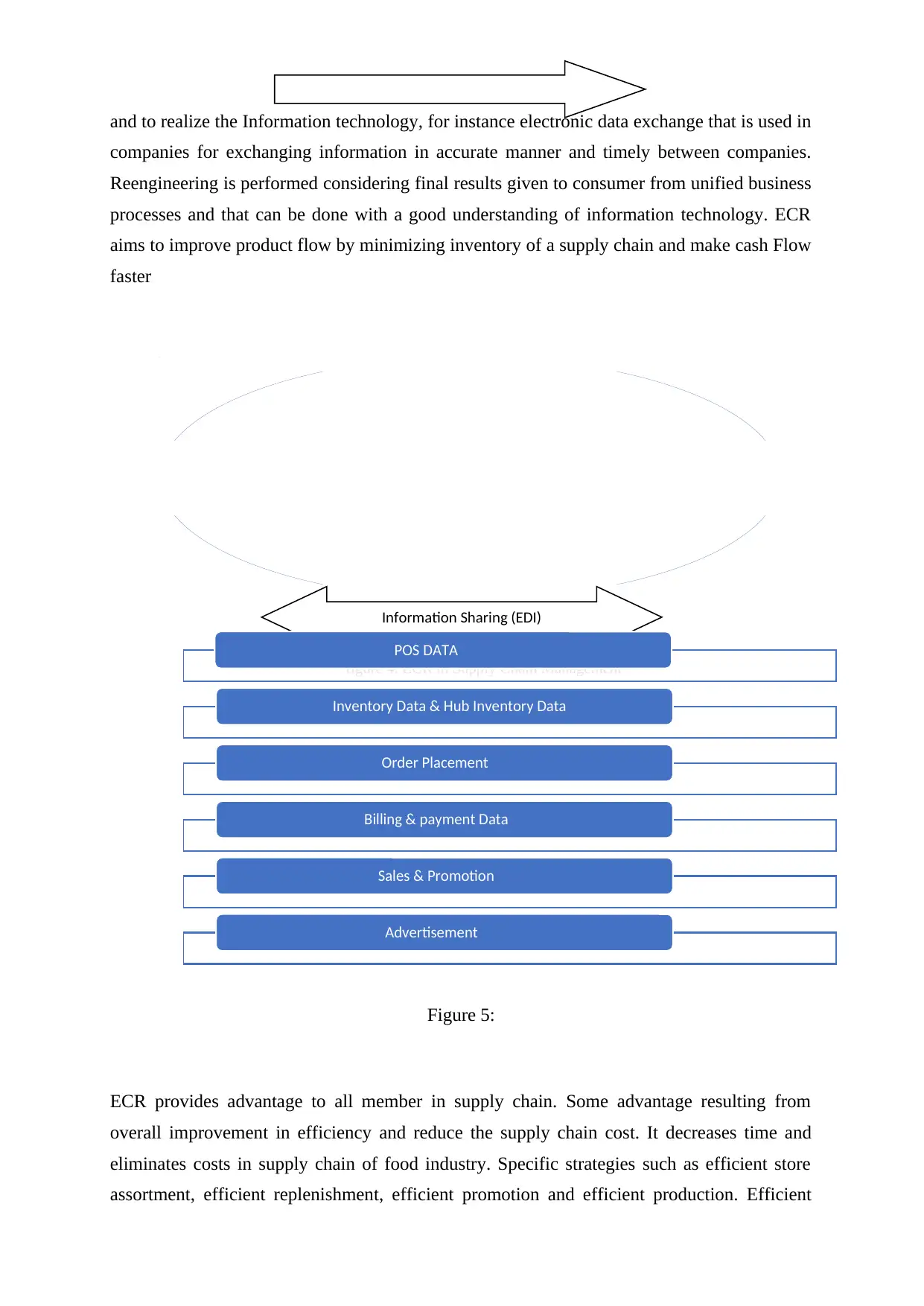
figure 4: ECR in Supply Chain Management
and to realize the Information technology, for instance electronic data exchange that is used in
companies for exchanging information in accurate manner and timely between companies.
Reengineering is performed considering final results given to consumer from unified business
processes and that can be done with a good understanding of information technology. ECR
aims to improve product flow by minimizing inventory of a supply chain and make cash Flow
faster
Figure 5:
ECR provides advantage to all member in supply chain. Some advantage resulting from
overall improvement in efficiency and reduce the supply chain cost. It decreases time and
eliminates costs in supply chain of food industry. Specific strategies such as efficient store
assortment, efficient replenishment, efficient promotion and efficient production. Efficient
Manufacturerwholesalerretailer(stores)Consumer
Information Sharing (EDI)
POS DATA
Inventory Data & Hub Inventory Data
Order Placement
Billing & payment Data
Sales & Promotion
Advertisement
and to realize the Information technology, for instance electronic data exchange that is used in
companies for exchanging information in accurate manner and timely between companies.
Reengineering is performed considering final results given to consumer from unified business
processes and that can be done with a good understanding of information technology. ECR
aims to improve product flow by minimizing inventory of a supply chain and make cash Flow
faster
Figure 5:
ECR provides advantage to all member in supply chain. Some advantage resulting from
overall improvement in efficiency and reduce the supply chain cost. It decreases time and
eliminates costs in supply chain of food industry. Specific strategies such as efficient store
assortment, efficient replenishment, efficient promotion and efficient production. Efficient
Manufacturerwholesalerretailer(stores)Consumer
Information Sharing (EDI)
POS DATA
Inventory Data & Hub Inventory Data
Order Placement
Billing & payment Data
Sales & Promotion
Advertisement
⊘ This is a preview!⊘
Do you want full access?
Subscribe today to unlock all pages.

Trusted by 1+ million students worldwide
1 out of 39
Related Documents
Your All-in-One AI-Powered Toolkit for Academic Success.
+13062052269
info@desklib.com
Available 24*7 on WhatsApp / Email
![[object Object]](/_next/static/media/star-bottom.7253800d.svg)
Unlock your academic potential
Copyright © 2020–2025 A2Z Services. All Rights Reserved. Developed and managed by ZUCOL.


